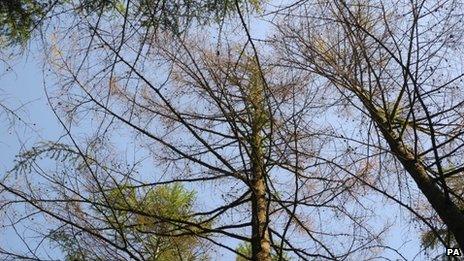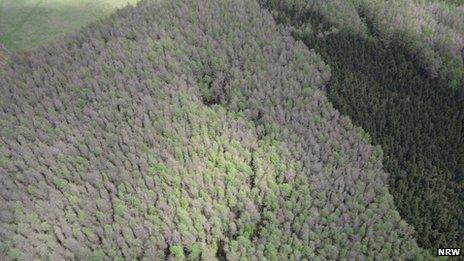Larch tree disease spreads to Gwynedd, Powys and Ceredigion
- Published

The disease has spread to larches in Gwynedd, Ceredigion and Powys.
Around 5m larches have been hit by a tree-killing disease which has spread into mid and north Wales.
More than £2m is being spent tackling the pathogen Phytophthora ramorum , externalafter helicopter surveys found it had moved into Gwynedd, Ceredigion and Powys.
Experts say they have been "surprised" by the speed it has spread.
Natural Resources Wales (NRW) started felling trees after the disease was found in the Afan Valley, Neath Port Talbot, in 2010.
It said it is taking urgent action to try to minimise the impact on the landscape and forestry and timber industries as it has spread to an area twice the size it was thought to occupy.
But experts are keen to point out that it poses no risk to human or animal health and that affected trees still have use to industry.
The disease has now been found at sites in Ceredigion, Powys and in Gwynedd at Coed Maentwrog, east of Porthmadog, and Coed Cymerau, near Blaenau Ffestiniog.
In the short term £500,000 will be spent by NRW cutting down trees around the edges of infected areas as the disease spreads tree to tree through airborne spores.
A further £1.7m will be used to remove infected trees and replant areas. New forest roads will also be constructed so areas can be cleared.
"This response shows how concerned we are about this disease because of its impact on timber markets, the landscape, woodland and other habitats," said Trefor Owen from NRW.
"We are liaising with the Welsh government and affected forest owners to see how the economic and other impacts can be minimised."
NRW says the weather over the last year has helped the spread of the disease with one of the wettest summers on record.
Last month's aerial surveys provided experts with the first opportunity to assess the trees as they come into leaf.
They also showed a "rapid" spread of the disease in England, Scotland and Northern Ireland.

The disease has now been found at Coed Cymerau, near Blaenau Ffestiniog
In Wales, surveys identified 2,500 hectares (6,100 acres) of new trees - about 2.5m - taking the total area of infection to more than 5,000 hectares (12,300 acres) containing about 5m larch trees.
About 1,200 hectares (2,900 acres) of larch trees have already been felled in Wales since the fungus-like organism was identified.
NRW said early indications that extensive felling contained the disease have since proved misleading.
Its new action includes a trial to see if injecting trees with a common herbicide could be effective in slowing the spread of the disease which poses no threat to human or animal health.
Woodland visitors are asked to take some "simple steps" to try to prevent spreading the disease by removing mud and plant material from clothing, boots and vehicles before leaving forests.
- Published29 May 2013
- Published14 June 2013